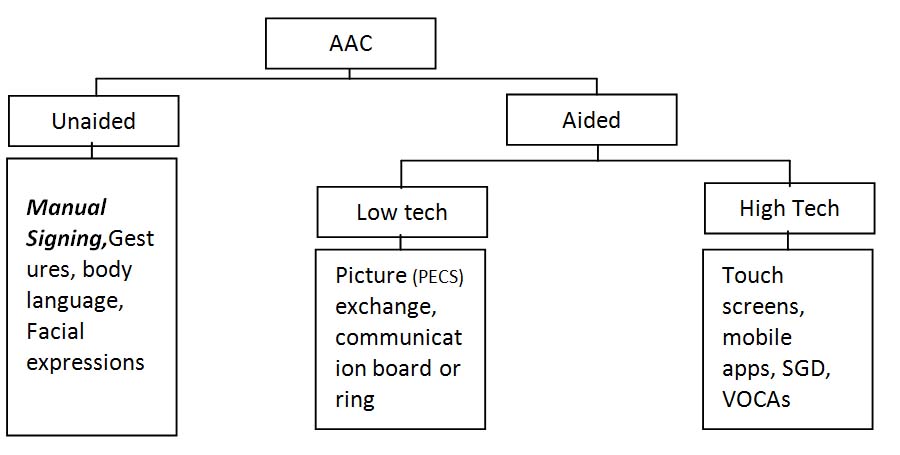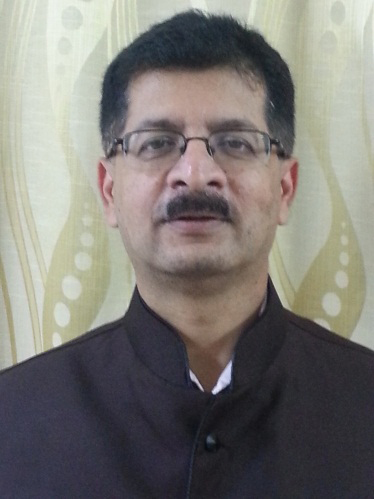Augmentative and alternative communication (AAC)
By: Dr. Suneel Godbole
As the world is growing with a rapid pace, so is the need of communication. Even children also are pushed to the edge; to express themselves at their best. Unfortunately, not all children are lucky to communicate easily and adapt to social environment. Sometimes day to day activities also become difficult due to these communication issues. Most of these problems have neither medicinal cure nor surgical correction! Even traditional speech therapies and special education are not enough to answer these limitations of communication. To overcome the communication barriers and improve the communication skills of children and adolescents; especially for those with severe communication disorders; the augmentative and alternative communication (AAC) system has been adopted in the special education program.
Before going ahead with understanding of AAC; let’s know some basic definitions; like –
Speech is talking, which is one way to express language. It involves the precisely coordinated muscle actions of the tongue, lips, jaw, and vocal tract to produce the recognizable sounds that make up language.
Language is a set of shared rules that allow people to express their ideas in a meaningful way. Language may be expressed verbally or by writing, signing, or making other gestures, such as eye blinking or mouth movements.
Communication is any form by which two people exchange information. They could use language, but they could also use gesture, facial expressions, signals, mimicry, visual or dramatic art, or any number of ways to express that information.
Thus, it is important to understand that Communication is all inclusive terminology which encompasses everything from utterances to gestures to words – anything which will help an individual to convey his needs / thoughts to another person effectively. Any severe limitation in this makes the life of an individual, more so for a child, miserable. AAC devices come in picture exactly to circumvent this problem.
Augmentative and alternative communication (AAC):
1) The supplementation (augmentation) or replacement (alternative) of natural speech and/or writing using aided and/or unaided symbols.
2) The field or area of clinical/educational practice to improve the communication skills of individuals with little or no functional speech.”
Augmentative and Alternative Communication Device:
Computer and non-computer based electronic devices that provide individuals whose natural speech is not functional with a means of communication.
History of AAC is quite interesting. The use of alternative methods of communication can be traced back to classical Rome and ancient Greece when Plato was writing about sign language used by deaf Athenians around 385 B.C. Around 1920, first communication board was created for F. hall Roe who had cerebral palsy.
In 1960, the Patient Operated Selector Mechanism (POSM), was a sip-and-puff typewriter controller created by Reg Maling for patients with paralysis.Blissymbolics created by Charles K. Bliss was used by Shirley McNaughton as an AAC method in 1971 for children with disabilities. Other systems – rebus symbols,Non-Speech language Acquisition Program, Autocon, voice output devices werealso developed during 1970 to 1990. Picture Exchange Communication System (PECS) also became quite popular.
As we entered 21st century, many computer aided AAC program and Voice Output Communication Aids (VOCA) were developed. By now use of AACs as an integral part of multicomponent approach to communication issues, especially for Autism Spectrum disorder, is well established.
Need for use of AAC
Though reliable global and Indian data is not available; the US data suggests that 1.3 percent (around 4 million) Americans may require AAC for their issues with communication. Another study from Norwayobserved that only 54% children with cerebral palsy (and with need for AAC) were using AAC devices. As the indications for need for AAC are increasing; for example rapid rise in number of children diagnosed of Autism Spectrum Disorder; the prevalence of need for use of AAC devices is bound to increase over the time.
Types of AAC
The AAC devices are broadly classifiedas –
- Unaided communication modes: rely on a user’s body movements (like gestures, manual signing (MS) and facial expressions)to represent an object, idea, action, or relationship.
- Aided communication modes:involve the use of auxiliary equipment to transmit messages. This includes the use of graphics, printed words, photographs, line drawings. Two subtypes –
- Low tech communication systems: communication books or boards (non-electric), written words on paper, photographs, line drawings and pictograms.
- High tech communication systems: include speech generating devices (SGDs) and speech generating device software on computers.

Aided communication aids can also be categorized as either exchange-based in which an individual hands over a graphic symbol in exchange for an object or activity supplied by the communication partner (e.g. Picture Exchange Communication System) or pointing-based in which an individual points to a symbol in order to communicate; e.g. About Me books, Boardmaker software, CHAT Now (Children’s Aided Language Tool), Pragmatically Organised Dynamic Displays (PODD), portable electronic speech-generating devices (SGDs), voice-output communication aids (VOCAs).
Now lets know 3 basic prototypes of AAC devices.
- Manual Signing:
Form: Unaided, Topography based
Description: Natural sign language, manual signs as a code for spoken language, gestures (formal or informal)
Rationale:
- Signs require gross motor movement and imitation skills, which are easier than skills required for speech.
- Signs are easier to promptthan speech sounds.
- Signs can be used in the absence of other social skills.
Examples: New Zealand Sign Language (NZSL), Makaton Sign Language system
Advantages:
- No auxiliary equipment
- Quick Accessible
- Flexible
- Inexpensive
Disadvantages:
- Not understood by general listeners
- Relies on complex motor skills and imitation skills
- Not useful in older children
- As in Autism Spectrum Disorder, if imitation skills are lacking then MS is not very useful.
- Picture Exchange
Form: Aided, Selection based (exchange- or pointing based), Low-tech, Non-electronic
Description: Two- or three dimensionalrepresentations of objects or concepts, line drawings, photographs.
Rationale: The PECS training protocol is based on Skinner’s (1957) analysis of verbal behavior and ABA-based instructional strategies. It has six phases in which children first learn to communicate with single pictures, and then choose among two or more pictures, and finally combine pictures to produce a variety of grammatical structures, semantic relationships, and communicative functions.
Examples: Picture Communication Symbols, Picture Exchange Communication System (PECS)
Advantages:
- Understood by listeners
- Visual stimuli i.e. recognition based
- Simple pointing/exchange, do not need to learn and remember new topographies
Disadvantages:
- Dependent on auxiliary equipment
- Requires training and Message preparation
- Listener must be in close proximity
- Speech Generation Devices (SGD):
Form: Aided, Selection based, (pointing based), High-tech, Electronic, Dedicated or non-dedicated
Description: Portable electronic device that displays graphic symbols, which represent a word or phrase andproduce (digitized or synthesized) speech output.
Rationale: SGDs typically display a variety of graphic symbols each of which may represent a word or phrase. When the word or phrase is activated, by touching or pressing a symbol, there is resulting voice-output.Studies found that majority of participants preferred using SGD to picture exchange or manual sign language.
Examples: Dedicated SGDs: Tech/Talk 6X8, BigMack, GoTalkŒ
Nondedicated SGDs: laptop/desktop, PDAs, cellphones (iPhone®, iPad®) withProloquo2Gosoftware.
Advantages:
- Readily understood by all listeners
- Portable, easily programmed
- Simple pointing/exchange
Disadvantages:
- Dependent on auxiliary equipment
- Dedicated: expensive, Cumbersome, time-consuming to program, stigmatize the user
- Nondedicated: expensive, easily damaged
Which children will be helped by AAC device?
- Autism spectrum disorder: Since social communication issue is one of the core issue in Autism Spectrum Disorder; introduction of AAC at early stage are rewarding. But the ultimate aim should be gradual shift to ‘Natural Language’. AAC devices would be just a ‘Stepping Stone’ in the whole journey towards communication independence.
- Profound and multiple learning disabilities,
- Cerebral palsy – AAC devices could change the quality of life in individuals with cerebral paly.
- Head/brain injury
- Aphonia, Primary progressive aphasia
- Genetic associations/syndromes (e.g. Prader-Willi, William’s, Rett, Angelman, Fragile X, Down, 22q.11 deletion)
- Progressive illnesses (e.g., multiple sclerosis, Huntington’s disease)
- Other neuromuscular diseases (e.g., muscular dystrophy, spinal muscular atrophy)
Criteria for Selection of AAC device:
Selection of AAC devices has to be ‘Individualized’. AAC device best suited for one child may not be useful for other. This is especially true with children with Autism Spectrum Disorder; where each child is unique. Here are some points to start for the Speech Language Pathologist, Teacher and Parent to work together.
- Child’s mobility and physical limitations – especially for low tech aids
- Family preferences and limitations
- Child’s cognitive level – awareness of basic cause – effect relationship
- Child’s visual and attention skills
- Child’s stage of Language Development
Starting with use of AAC systems
- Get familiar with the preferred communication method of the child.
- While talking / interacting with the child ALWAYS use the AAC device.
- Caregiver should frequently model use of AAC device to the child.
- Allow, encourage the child to play with and explore the AAC device.
- Let the AAC device be with the child 24 x 7 i.e. all through-out the day.
- Present child with plenty of opportunities to use the AAC device (e.g. asking the child things which he can tell with the help of AAC device)
- Caregiver should provide plenty of praise and positive support for each and every attempt of using AAC.
- There are many free and paid apps on the internet – global as well as Indian (avaz, Jellow…). One has to be very careful in selecting the right app as per the need and stage of language development of the child. If that is not considered; then it may become just a visual dictionary for the child and may cause deterioration in cognitive and communicative capabilities of the child.
AAC systems are useful in improving communication with individuals with severe communication disorder. Use of AAC devices in children is still limited due to many confounding factors like availability of right type of AAC devices, cost of AAC devices; limited availability of AAC trained Speech Language Pathologist, myth that AAC may limit use of spontaneous verbal communication etc. Ever growing number of children with Autism Spectrum disorder will be definitely helped by early use of proper AAC device along with other therapies.
With the advent of internet, mobiles and artificial intelligence; AAC systems are going to be so advanced that they may just follow child’s visual gaze or in future may read the thoughts in child’s brain and ‘Talk them aloud’; that too in socially and culturally acceptable way. The flip side is that there is a risk of getting addicted to the screen and diminishing the desire to develop natural language. This screen addiction and social disconnection is happening in normally able children also. So; we should be careful enough to use AAC devices as our ‘Faithful servants’ and Not to allow them to ‘Master’ us and our children!

